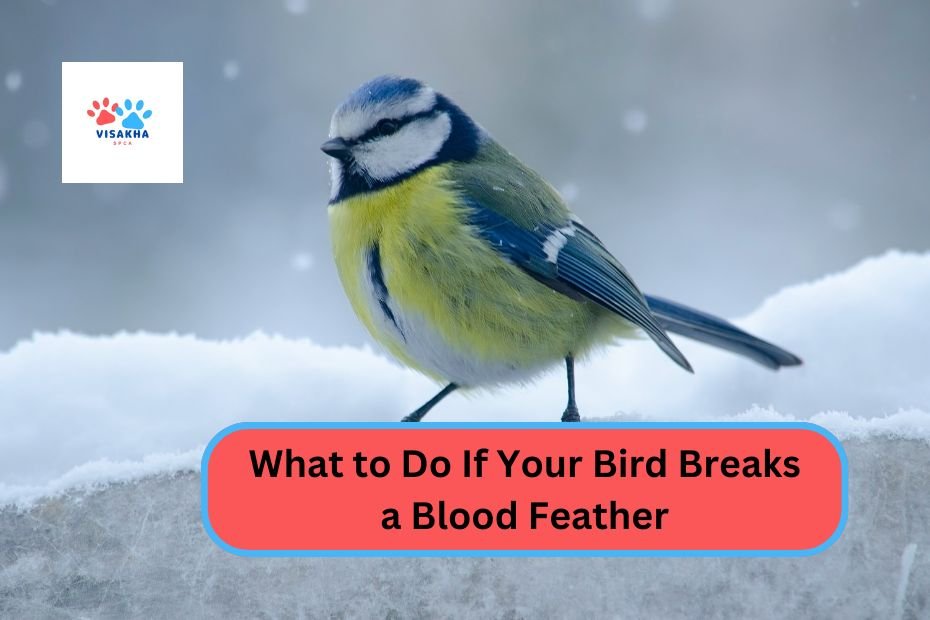A broken blood feather can be a concerning issue for bird owners. Blood feathers, also known as pin feathers, are new, growing feathers that contain a blood supply that helps the feather develop. If one of these feathers breaks, it can lead to bleeding and discomfort for your bird. While this situation may seem alarming, prompt action can prevent excessive blood loss and ensure your bird’s well-being.
In this guide, we’ll walk you through the steps to take if your bird breaks a blood feather and explain how to handle the situation safely.
What Are Blood Feathers?
Blood feathers are new feathers that grow in after molting or during the normal feather replacement process. Unlike mature feathers, which are fully developed and have no blood supply, blood feathers are filled with blood vessels to nourish the developing feather.
These feathers are more vulnerable to injury because of their delicate nature. They can be found on a bird’s wings, tail, or body, and you’ll recognize them by their dark-colored shaft, which indicates that blood is flowing through the feather.
Why Are Broken Blood Feathers a Concern?
A broken blood feather can cause your bird significant pain and bleeding. While some bleeding is not immediately life-threatening, birds have small blood volumes, so excessive blood loss can become dangerous if not treated quickly. Additionally, the feather may remain painful for your bird, leading to stress and discomfort.
If the bleeding is not addressed promptly, there is also a risk of infection or further injury to the broken feather shaft.
Steps to Take When Your Bird Breaks a Blood Feather
1. Stay Calm and Observe
The first step is to remain calm and avoid panicking. Your bird may already be stressed from the injury, and your calm demeanor can help soothe them. Gently approach your bird and observe the extent of the bleeding.
- Check for active bleeding: If the bleeding is minor, it may stop on its own. However, if there is continuous or heavy bleeding, you’ll need to take immediate action.
2. Restrain Your Bird Gently
To address a broken blood feather, you may need to restrain your bird. Have someone help you if possible, as birds can become agitated during this process.
- Use a towel: Gently wrap your bird in a soft towel to prevent them from flapping or moving too much, which could worsen the injury.
- Avoid squeezing: Handle your bird with care, ensuring that you don’t apply too much pressure, especially around the chest and back area, as birds need to expand their chests to breathe properly.
3. Stop the Bleeding
If the bleeding is minor, you can try to stop it using a styptic powder or cornstarch, both of which help to clot the blood. Here’s how:
- Styptic powder: If you have styptic powder (which is commonly used to stop bleeding in pet injuries), apply a small amount to the bleeding area.
- Cornstarch or flour: If you don’t have styptic powder, you can use cornstarch or flour as an alternative. Dip a cotton swab into the cornstarch and gently apply it to the base of the broken feather to stop the bleeding.
4. Remove the Broken Blood Feather (If Necessary)
In some cases, the broken blood feather may need to be removed to prevent further bleeding. This is a delicate process and should only be done if you’re confident or if the bleeding cannot be stopped through other means.
If you’re unsure or uncomfortable, it’s best to seek help from a veterinarian. However, if you need to remove the feather at home, here’s how to do it safely:
Steps to Remove a Blood Feather:
- Gather the right tools: You will need a pair of sterile tweezers or hemostats to pull the feather out.
- Locate the broken feather: Find the broken feather and identify the point where it connects to the skin (the base of the feather shaft).
- Pull the feather firmly: With the tweezers, grip the feather close to the base and pull it out in one smooth, firm motion. Make sure to pull in the direction of the feather’s growth to avoid causing extra pain or damage.
- Apply pressure: After removing the feather, apply gentle pressure to the area to stop any residual bleeding. You can use a cotton ball or gauze for this.
5. Clean the Area
Once the feather is removed, clean the area to prevent infection. Use a diluted antiseptic solution like chlorhexidine or betadine. Avoid using alcohol-based products as they can sting and irritate your bird’s skin.
6. Monitor Your Bird
After treating the broken blood feather, it’s important to monitor your bird closely for any signs of distress, ongoing bleeding, or infection. Watch for behaviors like:
- Lethargy: If your bird seems unusually tired or weak, this may be a sign of excessive blood loss.
- Picking or scratching: Your bird might pick at the injured area, increasing the risk of infection.
- Discoloration or swelling: These could indicate infection at the site of the broken feather.
7. Consult a Veterinarian
If you were unable to stop the bleeding or your bird shows signs of infection or distress after the incident, contact your avian veterinarian as soon as possible. A vet can assess the injury, provide professional treatment, and ensure that there are no other underlying health issues.
Preventing Blood Feather Injuries
While accidents can happen, there are some steps you can take to reduce the chances of your bird breaking a blood feather:
- Regular wing checks: Inspect your bird’s wings and body for any signs of new blood feathers, especially during molting.
- Avoid rough handling: Be gentle when handling your bird, and teach others in your household how to properly handle them to avoid injuries.
- Provide a safe environment: Make sure your bird’s cage is free from sharp objects, and offer appropriate perches and toys that don’t pose a risk of injury.
- Trim wings carefully: If you trim your bird’s wings, be cautious not to cut into blood feathers. If you’re unsure how to do this safely, have a veterinarian or professional trim your bird’s wings for you.
Conclusion
A broken blood feather can be alarming, but with prompt action, you can stop the bleeding and prevent further complications. By staying calm, treating the injury, and monitoring your bird closely, you can ensure their health and well-being. If you’re ever unsure about how to handle the situation, don’t hesitate to contact an avian veterinarian for professional advice.

